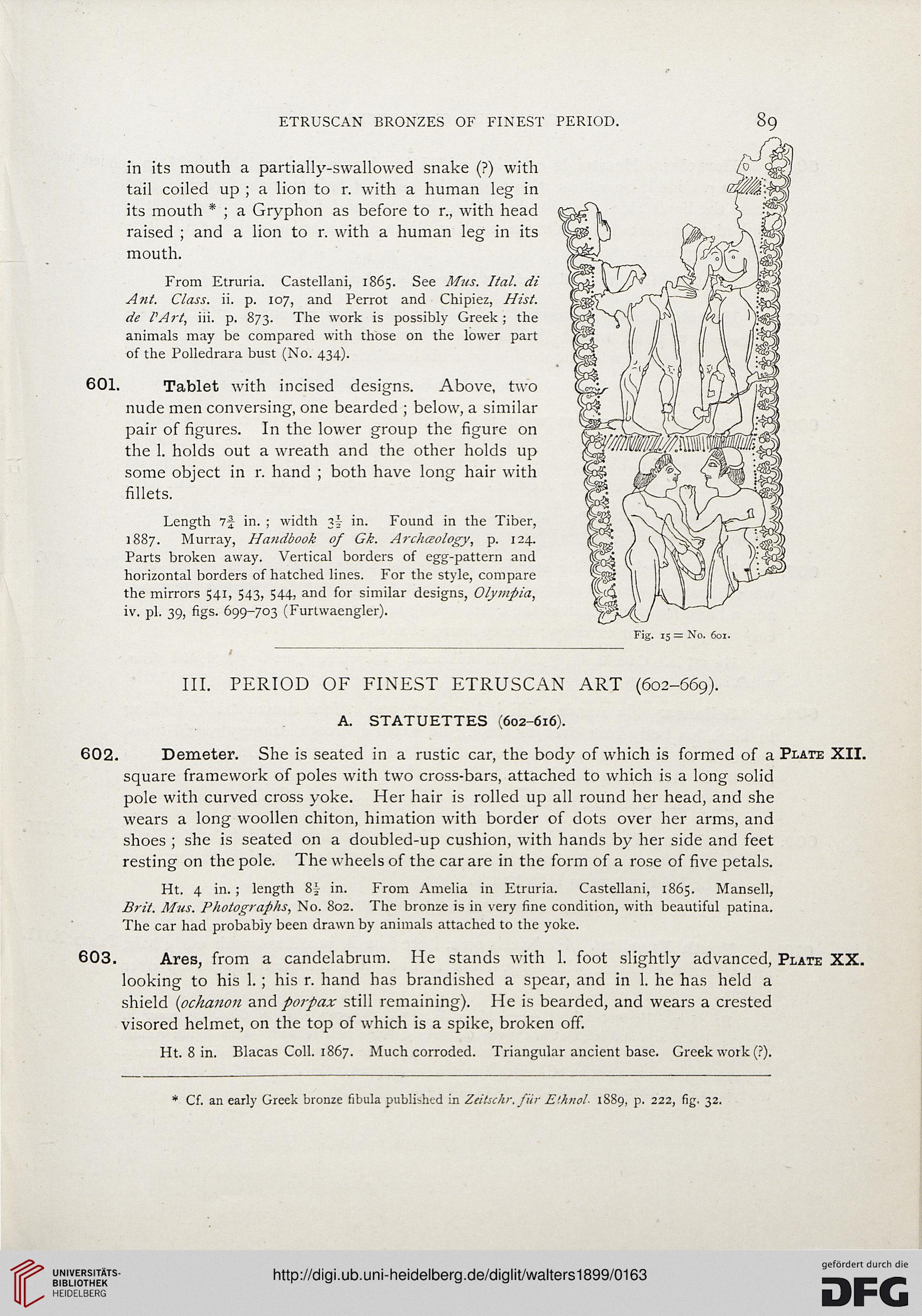ETRUSCAN BRONZES OF FINEST PERIOD.
in its mouth a partially-swallowed snake (?) with
tail coiled up ; a lion to r. with a human leg in
its mouth * ; a Gryphon as before to r., with head
raised ; and a lion to r. with a human leg in its
mouth.
From Etruria. Castellani, 1865. See Afiis. Ital. di
Ant. Class. ii. p. 107, and Perrot and Chipiez, Hist.
de PArt, iii. p. 873. The work is possibly Greek; the
animals may be compared with those on the lower part
of the Polledrara bust (No. 434).
601. Tablet with incised designs. Above, two
nude men conversing, one bearded ; below, a similar
pair of figures. In the lower group the figure on
the 1. holds out a wreath and the other holds up
some object in r. hand ; both have long hair with
fillets.
Length 7f in. ; width 3L in. Found in the Tiber,
1887. Murray, Handbook of Gk. Archceology, p. 124.
Parts broken away. Vertical borders of egg-pattern and
horizontal borders of hatched lines. For the style, compare
the mirrors 541, 543, 544, and for similar designs, Olympia,
iv. pl. 39, figs. 699-703 (Furtwaengler).
89
Fig. 15 = No. 601.
III. PERIOD OF FINEST ETRUSCAN ART (602-669).
A. STATUETTES (602-616).
602. Demeter. She is seated in a rustic car, the body of which is formed of a Plate XII.
square framework of poles with two cross-bars, attached to which is a long solid
pole with curved cross yoke. Her hair is rolled up all round her head, and she
wears a long woollen chiton, himation with border of dots over her arms, and
shoes ; she is seated on a doubled-up cushion, with hands by her side and feet
resting on the pole. The wheels of the car are in the form of a rose of five petals.
Ht. 4 in. ; length 8|- in. Froni Amelia in Etruria. Castellani, 1865. Mansell,
Brit. Mus. Photographs, No. 802. The bronze is in very fine condition, with beautiful patina.
The car had probabiy been drawn by animals attached to the yoke.
603. Ares, from a candelabrum. He stands with 1. foot slightly advanced, Plate XX.
looking to his 1.; his r. hand has brandished a spear, and in 1. he has held a
shield (ochanon and porpax still remaining). He is bearded, and wears a crested
visored helmet, on the top of which is a spike, broken off.
Ht. 8 in. Blacas Coll. 1867. Much corroded. Triangular ancient base. Greek work (?).
Cf. an early Greek bronze fibula published in Zdtschr. fiir Ethnol- 1889, p. 222, fig. 32.
in its mouth a partially-swallowed snake (?) with
tail coiled up ; a lion to r. with a human leg in
its mouth * ; a Gryphon as before to r., with head
raised ; and a lion to r. with a human leg in its
mouth.
From Etruria. Castellani, 1865. See Afiis. Ital. di
Ant. Class. ii. p. 107, and Perrot and Chipiez, Hist.
de PArt, iii. p. 873. The work is possibly Greek; the
animals may be compared with those on the lower part
of the Polledrara bust (No. 434).
601. Tablet with incised designs. Above, two
nude men conversing, one bearded ; below, a similar
pair of figures. In the lower group the figure on
the 1. holds out a wreath and the other holds up
some object in r. hand ; both have long hair with
fillets.
Length 7f in. ; width 3L in. Found in the Tiber,
1887. Murray, Handbook of Gk. Archceology, p. 124.
Parts broken away. Vertical borders of egg-pattern and
horizontal borders of hatched lines. For the style, compare
the mirrors 541, 543, 544, and for similar designs, Olympia,
iv. pl. 39, figs. 699-703 (Furtwaengler).
89
Fig. 15 = No. 601.
III. PERIOD OF FINEST ETRUSCAN ART (602-669).
A. STATUETTES (602-616).
602. Demeter. She is seated in a rustic car, the body of which is formed of a Plate XII.
square framework of poles with two cross-bars, attached to which is a long solid
pole with curved cross yoke. Her hair is rolled up all round her head, and she
wears a long woollen chiton, himation with border of dots over her arms, and
shoes ; she is seated on a doubled-up cushion, with hands by her side and feet
resting on the pole. The wheels of the car are in the form of a rose of five petals.
Ht. 4 in. ; length 8|- in. Froni Amelia in Etruria. Castellani, 1865. Mansell,
Brit. Mus. Photographs, No. 802. The bronze is in very fine condition, with beautiful patina.
The car had probabiy been drawn by animals attached to the yoke.
603. Ares, from a candelabrum. He stands with 1. foot slightly advanced, Plate XX.
looking to his 1.; his r. hand has brandished a spear, and in 1. he has held a
shield (ochanon and porpax still remaining). He is bearded, and wears a crested
visored helmet, on the top of which is a spike, broken off.
Ht. 8 in. Blacas Coll. 1867. Much corroded. Triangular ancient base. Greek work (?).
Cf. an early Greek bronze fibula published in Zdtschr. fiir Ethnol- 1889, p. 222, fig. 32.




